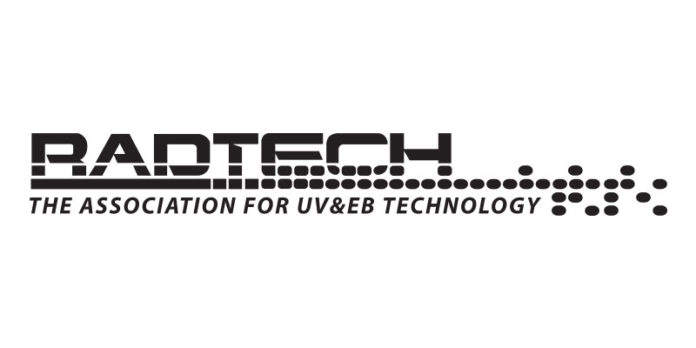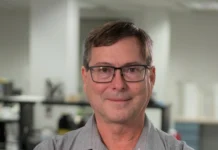RadTech, the nonprofit for UV+EB technology, has announced the winners of the 2021 RadLaunch Awards, which will be presented during an Awards Zoom Program, 3-4 p.m. EDT on April 28, 2021.
In addition to recognizing four RadLaunch winners, the judges offered a special Unique New Technology Award to recognize a potentially disruptive formative composites process.
The Awards Zoom Program, moderated by Darryl Boyd, US Naval Research Laboratory, and Mike Idacavage, Radical Curing LLC., is supported by RadTech members, its sponsors and RadLaunch platinum sponsor Azul 3D, and will feature short presentations by each award winner.
2021 RadLaunch Award Winners
Biomass Derived Chromophores for Radiation Curing
Prof. Jayaraman Sivaguru et al., Bowling Green State University, and Gregory Carroll, Ph.D., NRC Senior Research Associate at the Air Force Research Laboratory
The vibrant colors that enhance Nature’s elegance play a critical role in various chemical and biological processes. Translating these colors, which are dictated by the presence of chromophores, to curing technology is challenging as it requires rational manipulation of excited-state properties.
Jayaraman Sivaguru, Ph.D., the Antonia and Marshall Wilson Professor of Chemistry and Associate Director, Center for Photochemical Sciences, at Bowling Green State University, Ohio, is leading the effort in collaboration with Gregory Carroll, Ph.D., NRC Senior Research Associate at the Air Force Research Laboratory, Sruthy Baburaj, graduate student at Bowling Green and Sheila Asiago, PhD candidate at Bowling Green, as they explore translating biomass derived compounds that can be fine-tuned for radiation curing with both UV and visible light.
The biomass derived compounds are fine-tuned to feature photochemical properties superior to the conventional compounds featuring similar chromophores. Sivaguru’s team is working on translating these novel biomass derived compounds as curing systems with high efficiency.
Mighty Buildings
A construction technology company based in Oakland, California, Mighty Buildings is innovating the construction industry by creating beautiful, affordable and sustainable homes using 3D printing, advanced materials and robotics automation. Co-founders Alexey Dubov, Sam Ruben, Slava Solonitsyn and Dmitry Starodubtsev aim to unlock productivity in construction by combining 3D printing and prefab, making construction more sustainable, efficient and affordable.
The company’s large-scale 3D printers use a proprietary thermoset composite material that the co-founders invented, Light Stone Material (LSM), that can be 3D printed and that hardens almost immediately thanks to a UV-curing process, while also maintaining cohesion between layers to create a monolithic structure. LSM is four times lighter than concrete, has a high thermal resistance and is watertight, sturdy and fire resistant. This 3D printing technology allows Mighty Buildings to produce modular houses and building components much faster than traditional construction.
Mighty Buildings has a near-zero waste production process, preventing 1,100-2,000 kg of CO2 emission per 3D printed home. Committed to achieving Net-Zero by 2028, the company is 22 years ahead of the construction industry. Certified under California’s Factory Built Housing program to build units using 3D printing, the company is the first company to achieve certification under the UL 3401 standard for evaluating building structures and assemblies. Mighty Buildings is backed by notable international and Silicon Valley tech investors, including Khosla Ventures, Zeno Ventures and Y Combinator.
3D Printed Ceramic Resins
Tethon 3D
Tethon 3D, Omaha, Nebraska, manufactures universal UV photocurable ceramic resins that are used in numerous SLA, DLP and other vat polymerization 3D printers, and has an R&D facility that formulates custom additive manufacturing UV curable materials. Executive chairperson Karen Linder, Trent Allen, CEO and Gregory Pugh, CTO, lead the company to produce high quality ceramic materials for diverse industrial, consumer and design industries.
With over 1,000 customers in 40 countries, Tethon 3D serves clients in aerospace, electronics, defense, energy, biomedical and other industries that desire the physical properties of ceramics and the complex geometries made possible by 3F printing.
The company also sells a desktop DLP 3D printer optimized for highly viscous and/or opaque photopolymer composites, including ceramics and metals, and Tethon 3D offers proprietary resins for this printer. Tethon 3D accepts contracted service R&D projects to develop a variety of custom UV curable materials.
Multi-Color Visible Light Additive Manufacturing
Prof. Zachariah Page et al., University of Texas at Austin
A limitation to using high-energy UV/violet light in additive manufacturing is that degradation and attenuation narrow the scope of materials which can be used. While tapping visible light can open the door to more materials – including biological compounds, nanocomposites and materials with multiple structures – the photochemistry required for visible light has had unacceptably slow reaction times.
The research team led by Zachariah A. Page, Assistant Professor in the Department of Chemistry at The University of Texas at Austin, is developing high resolution stereolithographic 3D printing using different colors of low energy visible light to rapidly solidify resins. Key to the research is the team’s formulation of panchromatic photopolymer resins.
Utilizing visible light will enable “spectral control” – the ability to dictate the chemical reaction that occurs by the color of incident light used. This color-specificity provides the foundation for multicolor additive manufacturing (McAM) that will facilitate the fabrication of multi-material objects with unprecedented precision and functionality.
Unique New Technology Award
E-Beam X-Ray Cured Carbon Fiber Composites
Dan Montoney, Rapid Cure Technologies, and Anthony Berejka, Ionicorp+
The RadLaunch Unique New Technology Award will be presented to Dan Montoney, Rapid Cure Technologies, East Syracuse, New York, and Anthony Berejka, Ionicorp+, Huntington, New York, for their work developing and testing X-ray cured carbon fiber composites. Their work was supported by the New York State Energy Research and Development Authority.
It has been shown that X-rays generated by high powered electron beam accelerators (already used for decontamination of mail for the US Postal Service since 2002 and for medical device sterilization) can efficiently convert (meth)acrylate formulations commonly used in radiation curable coatings into functional cured matrices for carbon fiber composites, notably as used in automotive components.
This use of high intensity X-rays was found to be more energy efficient in curing carbon fiber reinforced composites than commonly used thermal curing. By being non-thermal, this treatment permits the use of less-expensive molds and also eliminates issues that arise from thermal expansion-contraction during curing. X-rays were even shown to cure through embedded metal, permitting the fabrication of hybrid items with metal inserts, such as potentially hinges for composite doors or trunk lids.
To register to join in as the Emerging Technology Award winners are introduced and celebrated on April 28, 2021 at 3 p.m. EDT, visit https://us02web.zoom.us/j/86886012865.






